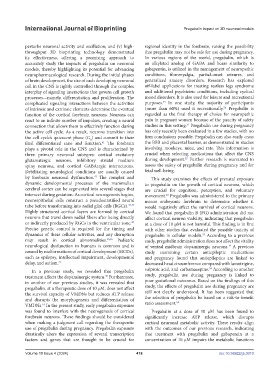Page 426 - IJB-10-4
P. 426
International Journal of Bioprinting Pregabalin impact on 3D neuronal models
perturbs neuronal activity and oscillation; and (v) high- regional identity in the forebrain, raising the possibility
throughput 3D bioprinting technology demonstrated that pregabalin may not be safe for use during pregnancy.
its effectiveness, offering a promising approach to In various regions of the world, pregabalin, which is
accurately study the impacts of pregabalin on neuronal an alkylated analog of GABA and bears similarity to
models, thereby highlighting its potential for advancing gabapentin, is utilized in the management of neuropathic
neuropharmacological research. During the initial phases conditions, fibromyalgia, partial-onset seizures, and
of brain development, the size of each developing neuronal generalized anxiety disorders. Research has explored
cell in the CNS is tightly controlled through the complex off-label applications for treating restless legs syndrome
interplay of signaling interactions that govern cell growth and additional psychiatric conditions, including cyclical
processes—namely, differentiation and proliferation. The mood disorders. It is also used for leisure and recreational
49
complicated signaling interactions between the activities purposes. In one study, the majority of participants
50
of intrinsic and extrinsic elements determine the eventual (more than 60%) used it recreationally. Pregabalin is
function of the cortical forebrain neurons. Neurons can regarded as the final therapy of choice for neuropathic
react to an infinite number of impulses, creating a neural pain in pregnant women because of the paucity of safety
51
connection that allows them to effectively function during studies in this setting. Pregabalin use during pregnancy
the active cell cycle. As a result, neurons transition into has only recently been evaluated in a few studies, with no
the cell cycle’s quiescent phase (G ) and commit to their firm conclusions possible. Pregabalin can also easily cross
0
final differentiated state and function. The forebrain the BBB and placental barrier, as demonstrated in studies
41
plays a pivotal role in the CNS and is characterized by involving monkeys, mice, and rats. This information is
three primary neuronal subtypes: cortical excitatory crucial when selecting medications that affect the CNS
52
glutamatergic neurons, inhibitory striatal medium during development. Further research is warranted to
spiny neurons, and cortical GABAergic interneurons. assess the safety of pregabalin during pregnancy and for
Debilitating neurological conditions are usually caused fetal well-being.
by forebrain neuronal dysfunction. The complex and This study examines the effects of prenatal exposure
42
dynamic developmental processes of the mammalian to pregabalin on the growth of cortical neurons, which
cerebral cortex can be segmented into several stages that are crucial for cognition, perception, and voluntary
intersect during gestation. As cortical neurogenesis begins, movement. Pregabalin was administered to the primary
20
neuroepithelial cells construct a pseudostratified neural mouse embryonic forebrain to determine whether it
tube before transforming into radial glial cells (RGCs). 43,44 would negatively affect the survival of cortical neurons.
Highly structured cortical layers are formed by cortical We found that pregabalin B (PG) administration did not
neurons that travel down radial fibers after being directly affect cortical neuron viability, indicating that pregabalin
or indirectly produced by RGCs in the ventricular zone. at a dose of 10 µM is not harmful. This finding is in line
45
Precise genetic control is required for the timing and with other studies that evaluated the possible toxicity of
dynamics of these cellular activities, and any disruption pregabalin in cellular models. According to a previous
53
may result in cortical abnormalities. 45,46 Pediatric study, pregabalin administration does not affect the vitality
neurological dysfunction in humans is common and is of ventral midbrain dopaminergic neurons. A previous
19
caused by malformations of cortical development (MCDs), study examining certain antiepileptic medications
such as epilepsy, intellectual impairment, developmental and pregnancy found that antiepileptics are linked to
delay, and autism. 47 decreased head circumference compared with lamotrigine,
54
In a previous study, we revealed that pregabalin valproic acid, and carbamazepine. According to another
treatment affects the dopaminergic system. Furthermore, study, pregabalin use during pregnancy is linked to
48
in another of our previous studies, it was revealed that poor gestational outcomes. Based on the findings of this
pregabalin, at a therapeutic dose of 10 µM, does not affect study, the effects of pregabalin use during pregnancy are
the survival capacity of VMDNs but reduces ATP release still not clearly understood. It has been suggested that
and disrupts the morphogenesis and differentiation of the selection of pregabalin be based on a risk-to-benefit
55
VMDNs. In the present study, early pregabalin exposure ratio assessment.
19
was found to interfere with the neurogenesis of cortical Pregabalin at a dose of 10 µM has been found to
forebrain neurons. These findings should be considered significantly increase ATP release, which disrupts
when making a judgment call regarding the therapeutic cortical neuronal metabolic activity. These results align
use of pregabalin during pregnancy. Pregabalin exposure with the outcomes of our previous research, indicating
drastically alters the expression of several transcription that treatment with pregabalin and gabapentin at a
factors and genes that are thought to be crucial for concentration of 10 µM impairs the metabolic functions
Volume 10 Issue 4 (2024) 418 doi: 10.36922/ijb.3010

